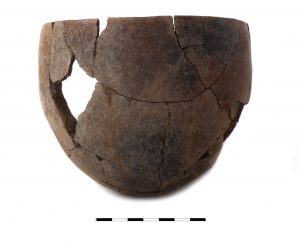Archaeologists unearthed remains of foetuses and infants that were buried in vessels used as urns at Khour Shambat in Omdurman, Sudan. The cemetery dates back 6000 years.

The Prehistoric graveyard and a nearby settlement cover nearly 2 hectares and were initially discovered by construction workers building a local road a couple of years ago. Polish archaeologists became involved in excavations of the site since 2012. Last season four graves containing remains of infants or foetuses were uncovered. According to Maciej Jórdeczka, who directed the excavations, the individuals were probably stillborn or died right after the birth. So far, archaeologists uncovered nearly 70 graves, of which over half dates to Neolithic, around 4500-4000 BC. The remains of the infants were placed in pottery vessels and buried with numerous grave goods. They included a necklace made of beads shaped from ostrich shell shards and bones, miniature pottery vessels, a stone cosmetic pallet, grinders, and oyster shells. Normally the older individuals were accompanied with grave goods, although rich burials of children are also known, but in the case of this cemetery, the older individuals were buried in the Neolithic without any objects.

The remains were placed in pottery vessels of different shapes and sizes, and covered with further vessels. Similar practices were recorded half a century ago in a small village in Sudan, where dead foetuses were placed in a vessel and buried on the courtyard. When a child was born and died after some time, then it was buried at a cemetery and not in a vessel. According to the researchers this tradition may be the clue to the interpretation of the pattern visible at the ancient site. Burials in vessels spread in 7th century BC and spread through Egypt in the 4th century. The oldest cases are however known from Sudan and are at lest 500 years older than these known from Egypt. During the excavations at the site, archaeologists also discovered traces of human activities earlier than the Neolithic remains – they date back to the 7th millennium BC.
(after Maciej Jórdeczka & Nauka w Polsce)